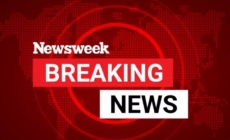-
I.C.C. Seeks Arrests of Taliban Leaders Over Persecution of Women - 12 mins ago
-
Woman’s arm is severed in Southern California train collision - 28 mins ago
-
Small Plane Crash in North Carolina Kills Buchanan Family of Four - 29 mins ago
-
Liberal Fund-Raising Drive Seeks $250 Million to Aid Pushback Against Trump - 56 mins ago
-
Chris Pratt Returns to Fan-Favorite Animated Role - about 1 hour ago
-
Dan Osborn’s Chances of Beating Republican Pete Ricketts in Nebraska - 2 hours ago
-
The French Seaside Factory Trying to Break China’s Chokehold on Rare Earths - 2 hours ago
-
ICE leaves cars, ice cream carts abandoned when it arrests workers - 2 hours ago
-
Pam Bondi Reacts to Missing Minute in Jeffrey Epstein Video - 2 hours ago
-
Attack on Cargo Ship in the Red Sea Kills 2 Crew Members - 2 hours ago
285 of 313 Air Traffic Control Facilities Are Understaffed
More than 90 percent of the country’s 313 air traffic control facilities operate below the Federal Aviation Administration’s recommended staffing levels, according to an analysis of staffing data from the union representing controllers obtained by The New York Times.
As of earlier this month, 285 facilities — which include traffic control towers and other locations — were below staffing thresholds set by the F.A.A. and the union. At 73 of those facilities, staffing is so low that at least a quarter of the work force is missing.
The U.S. air travel system remains among the safest in the world. But persistent staff shortages and a underinvestment in safety systems have led to an alarming number of close calls between aircraft.
The shortage is particularly severe in the New York region, where two crucial facilities on Long Island are operating with nearly 40 percent of the positions unfilled. These facilities direct air traffic for some of the busiest airports in the United States, including Newark, J.F.K. and LaGuardia, which handled a combined 1.2 million flights in the last year, according to data from the Port Authority of New York and New Jersey.
The F.A.A. did not immediately respond to a request for comment.
Efforts already underway to hire and train new controllers are expected to fall short of staffing demands, according to F.A.A. projections. Nearly three-quarters of facilities will still remain below recommended staffing levels after a long training process.
Improving the ranks may not happen quickly. It can take over four years to train a new air traffic controller at a certain facilities. At Ronald Reagan Washington National Airport, the site of the crash this week, training takes nearly 16 months, the data shows.
Emily Steel contributed reporting.




















